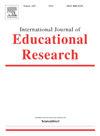Analysing menstrual education in Spanish adolescents: Perspectives from menstruating and non-menstruating individuals
IF 2.6
3区 教育学
Q1 EDUCATION & EDUCATIONAL RESEARCH
引用次数: 0
Abstract
Often shrouded in stigma and myth, menstruation requires a comprehensive understanding that takes into account biological, psychological, and social dimensions. We used a descriptive and cross-sectional survey to engage 300 adolescents from two high schools to assess their knowledge, beliefs, and sources of information concerning menstruation and the myths surrounding this issue. Our findings revealed a significant gap in menstrual education, with 79.33 % of participants expressing the need for more comprehensive information. A preference for disposable menstrual products was also observed, primarily influenced by cultural norms and a lack of awareness. The main sources of menstrual information for the participants were their mothers and friends, with educational institutions playing a lesser role. This study underscores the complexity of menstrual education, the influence of gender identity, and the prevalence of menstrual myths, which perpetuate a cycle of misinformation and stigma. Our research highlights the urgent need for inclusive and comprehensive menstrual education programs in schools. It also calls for initiatives that foster a positive menstrual experience, seek to destigmatize menstruation, and promote gender equality.
求助全文
约1分钟内获得全文
求助全文
来源期刊

International Journal of Educational Research
EDUCATION & EDUCATIONAL RESEARCH-
CiteScore
6.20
自引率
3.10%
发文量
141
审稿时长
21 days
期刊介绍:
The International Journal of Educational Research publishes regular papers and special issues on specific topics of interest to international audiences of educational researchers. Examples of recent Special Issues published in the journal illustrate the breadth of topics that have be included in the journal: Students Perspectives on Learning Environments, Social, Motivational and Emotional Aspects of Learning Disabilities, Epistemological Beliefs and Domain, Analyzing Mathematics Classroom Cultures and Practices, and Music Education: A site for collaborative creativity.
 求助内容:
求助内容: 应助结果提醒方式:
应助结果提醒方式:


